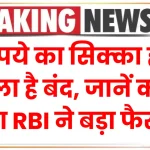
State Bank of India (SBI), India’s largest public sector bank, has announced a reduction in its External Benchmark-based Lending Rate (EBLR) and Repo Linked Lending Rate (RLLR). This move brings relief to home loan borrowers, as it will lead to lower Equated Monthly Installments (EMIs), making home ownership more affordable.
The decision comes after the Reserve Bank of India (RBI) cut the repo rate from 6.50% to 6.25%, prompting SBI and other banks to adjust their lending rates accordingly.
SBI Reduces EBLR and RLLR Rates
| Aspect | Details |
|---|---|
| SBI’s Revised EBLR | Reduced from 9.15% to 8.90% + Credit Risk Premium (CRP) |
| SBI’s Revised RLLR | Reduced from 8.75% to 8.50% + CRP |
| Effective From | February 15, 2025 |
| Repo Rate Change by RBI | Reduced from 6.50% to 6.25% |
| Other Banks Following Suit | Canara Bank, Punjab National Bank, Union Bank of India, Bank of Baroda |
| Who Benefits? | Home loan borrowers, personal loan customers, and other retail borrowers |
| EMI Impact | Lower EMIs or shorter loan tenure |
SBI’s decision to reduce EBLR and RLLR rates brings welcome relief for home loan borrowers. With lower EMIs, more affordable housing loans, and faster repayment options, this move makes home ownership easier. Borrowers should check their loan terms, explore refinancing options, and plan their finances to maximize savings.
What is EBLR and RLLR?
Before we dive deeper, let’s understand what EBLR and RLLR mean and how they impact loan borrowers.
1. External Benchmark-based Lending Rate (EBLR)
EBLR is directly linked to an external benchmark, such as the RBI’s repo rate. Changes in the repo rate lead to immediate changes in loan interest rates, making it highly responsive to market conditions.
2. Repo Linked Lending Rate (RLLR)
RLLR is another benchmark where interest rates are linked to the RBI’s repo rate. When the repo rate decreases, RLLR-based loan rates also decrease, leading to lower EMIs for borrowers.
Since both rates are directly influenced by the repo rate, home loan borrowers with EBLR or RLLR-based loans will see immediate reductions in their EMI payments.
see also: How to Start State Bank of India (SBI) Net Banking
How Does This Impact Home Loan Borrowers?
If you have an existing home loan linked to EBLR or RLLR, you will benefit in the following ways:
1. Lower EMIs
With SBI reducing its lending rates, home loan borrowers will pay less interest on their loans, thereby reducing their monthly EMIs. This can significantly ease financial burdens, especially for long-term loans.
2. More Affordable Housing Loans
For new borrowers, this reduction means you can secure a home loan at lower interest rates, making home buying more affordable.
3. Shorter Loan Tenure
Instead of reducing EMIs, some borrowers may choose to keep their EMI amount the same and reduce their loan tenure, which helps them repay loans faster.
4. Higher Loan Eligibility
With lower interest rates, borrowers might qualify for higher loan amounts, making it easier to finance their dream homes.
5. Better Investment Opportunities
Lower loan costs mean you can divert savings toward other investment options, such as mutual funds or fixed deposits.
Example: EMI Reduction Calculation
To understand how this impacts your EMI, let’s consider a practical example:
- Loan Amount: ₹50,00,000
- Tenure: 20 years
- Old Interest Rate (9.15%)
- EMI: ₹45,419
- New Interest Rate (8.90%)
- EMI: ₹44,821
- Total Savings: ₹7,152 per year (₹5,964 monthly reduction x 12 months)
This reduction can lead to substantial savings over the loan tenure.
What Should Borrowers Do?
1. Check Your Loan Agreement
Find out whether your loan is linked to EBLR, RLLR, or MCLR. Only EBLR and RLLR loans will see automatic reductions.
2. Consider Refinancing
If your home loan is based on MCLR or a fixed rate, you might consider switching to an EBLR-based loan to benefit from these rate cuts.
3. Contact Your Bank
Speak with your loan officer or visit your nearest SBI branch to check how the new rates impact your existing loan.
4. Plan for Future Savings
With lower EMIs, consider increasing prepayments to reduce interest costs further.
5. Use EMI Calculators
Use an EMI calculator on SBI’s website to estimate your new repayment schedule.
How Does This Compare to Other Banks?
SBI is not the only bank reducing rates. Other major banks have also cut lending rates:
- Canara Bank: RLLR reduced by 25 bps
- Punjab National Bank (PNB): RLLR reduced by 25 bps
- Union Bank of India: RLLR reduced by 25 bps
- Bank of Baroda: Similar reductions
These reductions indicate a broader trend in the Indian banking sector to make loans more affordable.
see also: Senior Citizen Savings Scheme: Earn a Stable Monthly Income with This Secure Post Office Plan
SBI Reduces EBLR and RLLR Rates FAQs
1. Who benefits from SBI’s rate reduction?
Any borrower with EBLR or RLLR-linked loans will see an automatic reduction in EMIs.
2. Will this affect fixed-rate loans?
No, fixed-rate loans remain unchanged unless refinanced.
3. How much will my EMI reduce?
The exact reduction depends on your loan amount, tenure, and interest rate. For example, a ₹50 lakh loan over 20 years will see an EMI reduction of ₹5,964 per year.
4. Should I switch from MCLR to EBLR?
If you are on an MCLR-based loan, switching to EBLR or RLLR can help you benefit from faster rate reductions.
5. Where can I check my revised EMI?
Visit SBI’s official website sbi.co.in or use an EMI calculator to check updated repayments.











